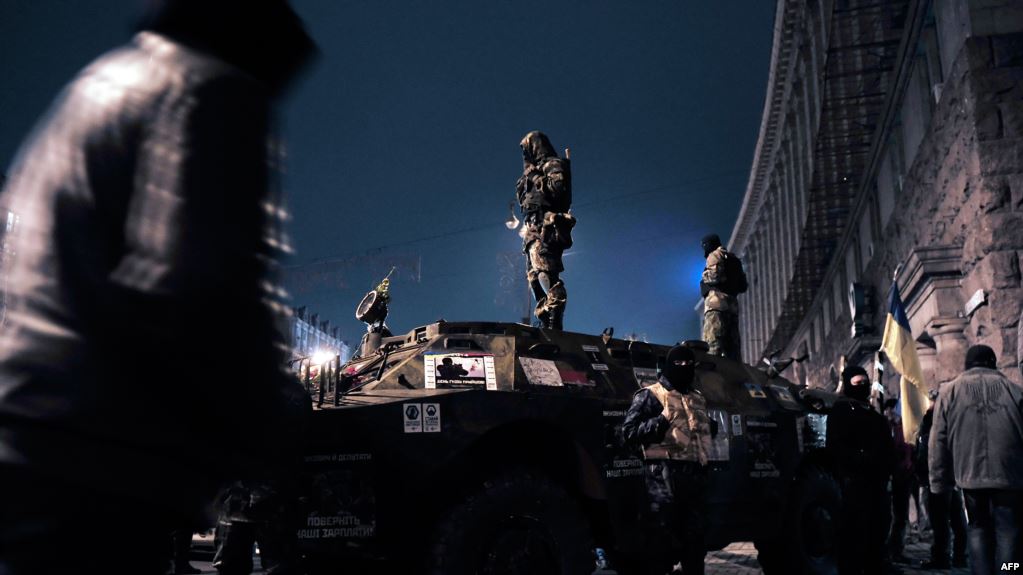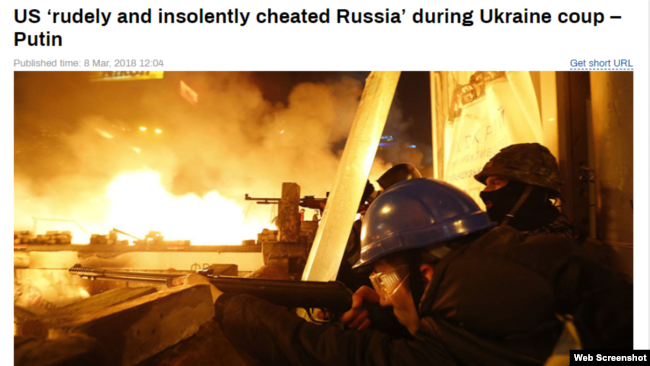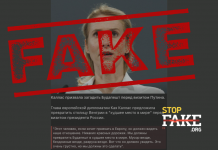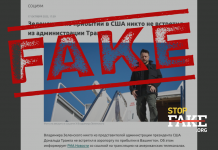
By Polygraph
The U.S. used Russia to prevent Ukrainian leader Viktor Yanukovich from using his military against rioters in Kiev, and then ‘cheated’ Moscow by supporting an armed coup, President Vladimir Putin said.
On March 8, the Russian government-funded broadcaster RT published a story that focused on remarks President Vladimir Putin made during a television interview, in which he claimed that the U.S. and its Western allies “cheated” Russia by supporting an armed coup in Ukraine in February 2014.
“Here is something not publicly known,” Putin said to his interviewer in a documentary called World Order 2018.
“At this very moment, our American partners called us and asked to do everything – and that’s almost a quote – to ensure that Yanukovich didn’t use the army, so that the opposition could clear the squares and governmental buildings on its own terms and go on towards the implementation of the agreement,” the Russian President said.
Putin then claimed that his Western “partners” gave no warning about what he called a “coup,” which he alleges they supported.
“They could have at least called us, do something, say a word! They could have said, ‘It was a case of agents stepping out of line, but we will fix it and turn everything into the bounds of the law,’” Putin said.
“Not a word! On the contrary, there was full support of those who committed this coup,” he continued.“This is what they did with their own hands. How can they not support the current leadership now? They put themselves into a corner.”
In fact, what occurred in Ukraine in February 2014 was not an armed coup, and there is no credible evidence that protesters were “agents” of the United States or any other country. After government snipers and riot police killed dozens of protesters on February 20, a small minority of protesters acquired rudimentary weapons, including so-called “traumatic” (non-lethal) pistols, air rifles, and hunting rifles. This can be seen even in the photo RT used for this story: the man in the foreground appears to be armed with an air rifle or small-caliber sporting rifle.
None of these weapons proved a match for trained police armed with fully automatic Kalashnikovs and a variety of sniper rifles.
It is also important to remember that only a handful of buildings in the center of Kyiv were ever occupied by protesters, some of which were non-governmental buildings whose owners voluntarily allowed protesters to use their facilities.
The basis for Putin’s accusation is the February 21 agreement signed between then-Ukrainian President Viktor Yanukovych and the leaders of the parliamentary opposition parties, whom many saw as leaders of the Maidan protest movement (though this was disputed by many protesters themselves). Putin, like other Russian politicians and media figures, has repeatedly implied that the U.S. somehow exercised control over the protesters, who ignored the agreement and supposedly led an all-out assault to seize power. This is not how events played out.
Protest leaders have said they received phone calls from commanders of individual police units asking for safe passage out of Kyiv, which was granted. In the early morning hours of February 22, Yanukovych left his private residence of Mezhyhirya outside the city by helicopter, bound for Kharkiv in the eastern part of the country. Eyewitnesses said the disappearance of the riot police guarding his residential compound coincided with Yanukovych’s flight, with protesters showing up later. Yanukovych traveled from Kharkiv to his native city of Donetsk, then to the Crimea, and wound up in Russia, where he resides to this day.
Rather than being driven from power by a coup, there is evidence suggesting that Viktor Yanukovych was already planning to leave Kyiv before signing the February 21 agreement. Security camera footage shows his staff removing valuables from his Mezhyhirya compound on February 19.
Other security footage shows valuables being removed on February 21, clearly during the day.
The agreement was signed in the evening, when it was already dark in Kyiv. Based on reports at the time, the Ukranian leader said while in Kharkiv that he had not resigned, but it became clear soon after leaving that his party allies had abandoned him. When he failed to leave on a plane from Donetsk airport, he then left by car and made his way to Crimea and later Russia. (see NYT article linked above) Yanukovych’s plan to leave was in place before riot police began abandoning their positions.
What is (and isn’t) a coup
By definition, a coup d’etat is when members of a country’s political elite, most often military officers, seize power by force. That is not what happened in Kyiv in 2014. The military played virtually no role, and the only military unit mobilized during these events was ordered to come to Kyiv to help suppress the protesters, not help them. Those personnel were blockaded in their barracks and never made it to the capital.
Viktor Yanukovych was not removed as the result of machinations of his country’s political or military elite. He provoked protests through his own actions (refusing to sign an EU association agreement he had promised for years and then violently cracking down on protesters), and then planned to flee the capital, apparently hoping he could rebuild his power base outside Kyiv until planned December 2014 elections. Instead, his allies abandoned him, and so he abandoned Ukraine.
Later in the RT article, Putin is quoted on the topic of post-Maidan Ukraine.
“If they did it a little different, Ukraine would have benefited much more. Our co-operation links would not have been broken. Entire industries in Ukraine would have still existed,” Putin said.
What Putin and the RT article neglected to mention is the Russian invasion and annexation of the Crimea and the presence of Russian nationals fighting with separatists of Ukraine’s Donbas region, which lead to the breakdown in Russian-Ukrainian relations.
By Polygraph





